High-Efficiency Plasmonic Lens Based on Archimedes-Spiral with Cross Section of an Asymmetric Slot
Abstract
1. Introduction
2. Materials and Methods
3. Results and Discussion
3.1. Unidirectional Excitation of SPPs with a 2D Asymmetric Slot
3.2. Analysis of the Plasmonic Lens Based on Spiral Slot Illuminated by a Circularly Polarized Beam
3.3. Analysis of the Plasmonic Lens Based on a Spiral Slot Illuminated by a Linearly Polarized Beam
4. Conclusions
Author Contributions
Funding
Data Availability Statement
Conflicts of Interest
References
- Rothenhäusler, B.; Knoll, W. Surface plasmon microscopy. Nature 1988, 332, 615–617. [Google Scholar] [CrossRef]
- Mao, Y.; Chang, S.; Sherif, S.; Flueraru, C. Graded-index fiber lens proposed for ultrasmall probes used in biomedical imaging. Appl. Opt. 2007, 46, 5887–5894. [Google Scholar] [CrossRef] [PubMed]
- Fang, N.; Lee, H.; Sun, C.; Zhang, X. Sub-diffraction-limited optical imaging with a silver superlens. Science 2005, 308, 534–537. [Google Scholar] [CrossRef] [PubMed]
- Liu, Z.; Lee, H.; Xiong, Y.; Sun, C.; Zhang, X. Far-field optical hyperlens magnifying sub-diffraction-limited objects. Science 2007, 315, 1686. [Google Scholar] [CrossRef]
- Srituravanich, W.; Pan, L.; Wang, Y.; Sun, C.; Bogy, D.; Zhang, X. Flying plasmonic lens in the near field for high-speed nanolithography. Nat. Nanotechnol. 2008, 3, 733–737. [Google Scholar] [CrossRef] [PubMed]
- Liu, Z.W.; Wei, Q.H.; Zhang, X. Surface plasmon interference nanolithography. Nano Lett. 2005, 5, 957–961. [Google Scholar] [CrossRef]
- Pang, Y.; Gordon, R. Optical trapping of 12 nm dielectric spheres using double-nanoholes in a gold film. Nano Lett. 2011, 11, 3763–3767. [Google Scholar] [CrossRef]
- Tsai, W.Y.; Huang, J.S.; Huang, C.B. Selective trapping or rotation of isotropic dielectric microparticles by optical near field in a plasmonic archimedes spiral. Nano Lett. 2014, 14, 547–552. [Google Scholar] [CrossRef]
- Roxworthy, B.J.; Ko, K.D.; Kumar, A.; Fung, K.H.; Chow, E.K.C.; Liu, G.L.; Fang, N.X.; Toussaint, K.C. Application of plasmonic bowtie nanoantenna arrays for optical trapping, stacking, and sorting. Nano Lett. 2012, 12, 796–801. [Google Scholar] [CrossRef]
- Wang, K.; Schonbrun, E.; Steinvurzel, P.; Crozier, K.B. Scannable plasmonic trapping using a gold stripe. Nano Lett. 2010, 10, 3506–3511. [Google Scholar] [CrossRef]
- Haes, A.J.; Zou, S.; Schatz, G.C.; Duyne, R.P.V. Nanoscale optical biosensor: Short range distance dependence of the localized surface plasmon resonance of noble metal nanoparticles. J. Phys. Chem. B 2004, 108, 6961–6968. [Google Scholar] [CrossRef]
- Dahlin, A.; Zäch, M.; Rindzevicius, T.; Käll, M.; Sutherland, D.S.; Höök, F. Localized surface plasmon resonance sensing of lipid-membrane-mediated biorecognition events. J. Am. Chem. Soc. 2005, 127, 5043–5048. [Google Scholar] [CrossRef] [PubMed]
- Zhao, C.; Zhang, J. Binary plasmonics: Launching surface plasmon polaritons to a desired pattern. Opt. Lett. 2009, 34, 2417–2419. [Google Scholar] [CrossRef] [PubMed]
- Li, H.; Yan, L.S.; Guo, Z.; Pan, W.; Wen, K.H.; Luo, X. Enhanced focusing properties using surface plasmon multilayer gratings. IEEE Photonics J. 2012, 4, 57–64. [Google Scholar] [CrossRef]
- Lerman, G.M.; Yanai, A.; Levy, U. Demonstration of nanofocusing by the use of plasmonic lens illuminated with radially polarized light. Nano Lett. 2009, 9, 2139–2143. [Google Scholar] [CrossRef]
- Lv, X.M.; Qiu, W.B.; Wang, J.X.; Ma, Y.H.; Zhao, J.; Li, M.K.; Yu, H.Y.; Pan, J.Q. A chirped subwavelength grating with both reflection and transmission focusing. IEEE Photonics J. 2013, 5, 2200907. [Google Scholar]
- Zhang, Q.; Shan, X.Y.; Zhou, L.; Zhan, T.R.; Wang, C.X.; Li, M.; Jia, J.F.; Zi, J.; Wang, Q.Q.; Xue, Q.K. Scattering focusing and localized surface plasmons in a single ag nanoring. Appl. Phys. Lett. 2010, 97, 261107. [Google Scholar] [CrossRef]
- Fu, Y.; Liu, H.; Zhou, X.; Xu, Z.; Fang, F. Experimental investigation of superfocusing of plasmonic lens with chirped circular nanoslits. Opt. Express 2010, 18, 3438–3443. [Google Scholar] [CrossRef]
- Zhang, M.; Du, J.; Shi, H.; Yin, S.; Xia, L.; Jia, B.; Gu, M.; Du, C. Three-dimensional nanoscale far-field focusing of radially polarized light by scattering the spps with an annular groove. Opt. Express 2010, 18, 14664–14670. [Google Scholar] [CrossRef]
- Wang, E.W.; Li, L.L.; Yu, W.X.; Wang, T.S.; Gao, J.S.; Fu, Y.Q.; Liu, Y.L. The focusing property of immersed plasmonic nanolenses under radially polarized illumination. IEEE Photonics J. 2013, 5, 4500207. [Google Scholar] [CrossRef]
- Chen, J. Numerical study of a nonplanar two-stage surface plasmonic lens illuminated by a radially polarized beam. Plasmonics 2013, 8, 931–936. [Google Scholar] [CrossRef]
- Jia, S.; Wu, Y.; Wang, X.; Wang, N. A subwavelength focusing structure composite of nanoscale metallic slits array with patterned dielectric substrate. IEEE Photonics J. 2014, 6, 4800108. [Google Scholar] [CrossRef]
- Gjonaj, B.; David, A.; Blau, Y.; Spektor, G.; Orenstein, M.; Dolev, S.; Bartal, G. Sub-100 nm focusing of short wavelength plasmons in homogeneous 2d space. Nano Lett. 2014, 14, 5598–5602. [Google Scholar] [CrossRef]
- Takeda, M.; Kimura, N.; Inoue, T.; Aizawa, K. Plasmonic lens with multi-circular-slit apertures for improvement of light utilization efficiency. Jpn. J. Appl. Phys. 2015, 54, 09MG02. [Google Scholar] [CrossRef]
- Zhao, C.; Zhang, J.; Liu, Y. Light manipulation with encoded plasmonic nanostructures. EPJ Appl. Metamater. 2014, 1, 6. [Google Scholar] [CrossRef][Green Version]
- Zhao, C.; Zhang, J. Flexible wavefront manipulation of surface plasmon polaritons without mechanical motion components. Appl. Phys. Lett. 2011, 98, 211108. [Google Scholar] [CrossRef]
- Chen, W.; Abeysinghe, D.C.; Nelson, R.L.; Zhan, Q. Plasmonic lens made of multiple concentric metallic rings under radially polarized illumination. Nano Lett. 2009, 9, 4320–4325. [Google Scholar] [CrossRef]
- Darak, M.S.; Mote, R.G.; Shukla, S. Asymmetry-Based Plasmonic Phase Manipulation for a Compact Far-Field Optical Lens. Adv. Photonics Res. 2020, 1, 2000018. [Google Scholar] [CrossRef]
- Mote, R.G.; Minin, O.V.; Minin, I.V. Focusing behavior of 2-dimensional plasmonic conical zone plate. Opt. Quantum Electron. 2017, 49, 271. [Google Scholar] [CrossRef]
- Wang, S.; He, J.; Qu, S.; Zhang, Y. Metasurface Lens for both Surface Plasmon Polaritons and Transmitted Wave. Plasmonics 2016, 12, 621–626. [Google Scholar] [CrossRef]
- Shi, W.B.; Chen, T.Y.; Jing, H.; Peng, R.W.; Wang, M. Dielectric lens guides in-plane propagation of surface plasmon polaritons. Opt. Express 2017, 25, 5772. [Google Scholar] [CrossRef] [PubMed]
- Li, G.; Sun, Y.; Wang, S. Spin-Independent Plasmonic Lens. Nanoscale Res. Lett. 2019, 14, 156. [Google Scholar] [CrossRef] [PubMed]
- Liu, Z.; Steele, J.M.; Srituravanich, W.; Pikus, Y.; Sun, C.; Zhang, X. Focusing surface plasmons with a plasmonic lens. Nano Lett. 2005, 5, 1726–1729. [Google Scholar] [CrossRef] [PubMed]
- Zhu, M.; Zhang, D.; Zhu, L.; Chen, J. A near infrared broadband surface plasmonic lens constructed with multiple couplers with unidirectional propagation property. Plasmonics 2015, 10, 1315–1323. [Google Scholar] [CrossRef]
- Steele, J.M.; Liu, Z.; Wang, Y.; Zhang, X. Resonant and non-resonant generation and focusing of surface plasmons with circular gratings. Opt. Express 2006, 14, 5664–5670. [Google Scholar] [CrossRef]
- Song, W.; Fang, Z.; Huang, S.; Lin, F.; Zhu, X. Near-field nanofocusing through a combination of plasmonic bragg reflector and converging lens. Opt. Express 2010, 18, 14762–14767. [Google Scholar] [CrossRef]
- Zhong, Y.; Wen, J.; Chen, J.; Zhu, L.; Gao, X.; Tao, C.; Zhang, D. A highly efficient plasmonic lens based on a single annular ring with cross section of an asymmetric slot. IEEE Photonics J. 2016, 8, 4801309. [Google Scholar] [CrossRef]
- Takeda, M.; Okuda, S.; Inoue, T.; Aizawa, K. Focusing characteristics of a spiral plasmonic lens. Jpn. J. Appl. Phys. 2013, 52, 09LG03. [Google Scholar] [CrossRef]
- Gou, Q.; Zhang, C.; Hu, X. A spiral plasmonic lens with directional excitation of surface plasmons. Sci. Rep. 2016, 6, 32345. [Google Scholar]
- Yao, W.; Liu, S.; Liao, H.; Li, Z.; Sun, C.; Chen, J.; Gong, Q. Efficient directional excitation of surface plasmons by a single-element nanoantenna. Nano Lett. 2015, 15, 3115–3121. [Google Scholar] [CrossRef]
- Johnson, P.B.; Christy, R.W. Optical constants of the noble metals. Phys. Rev. B 1972, 6, 4370. [Google Scholar] [CrossRef]
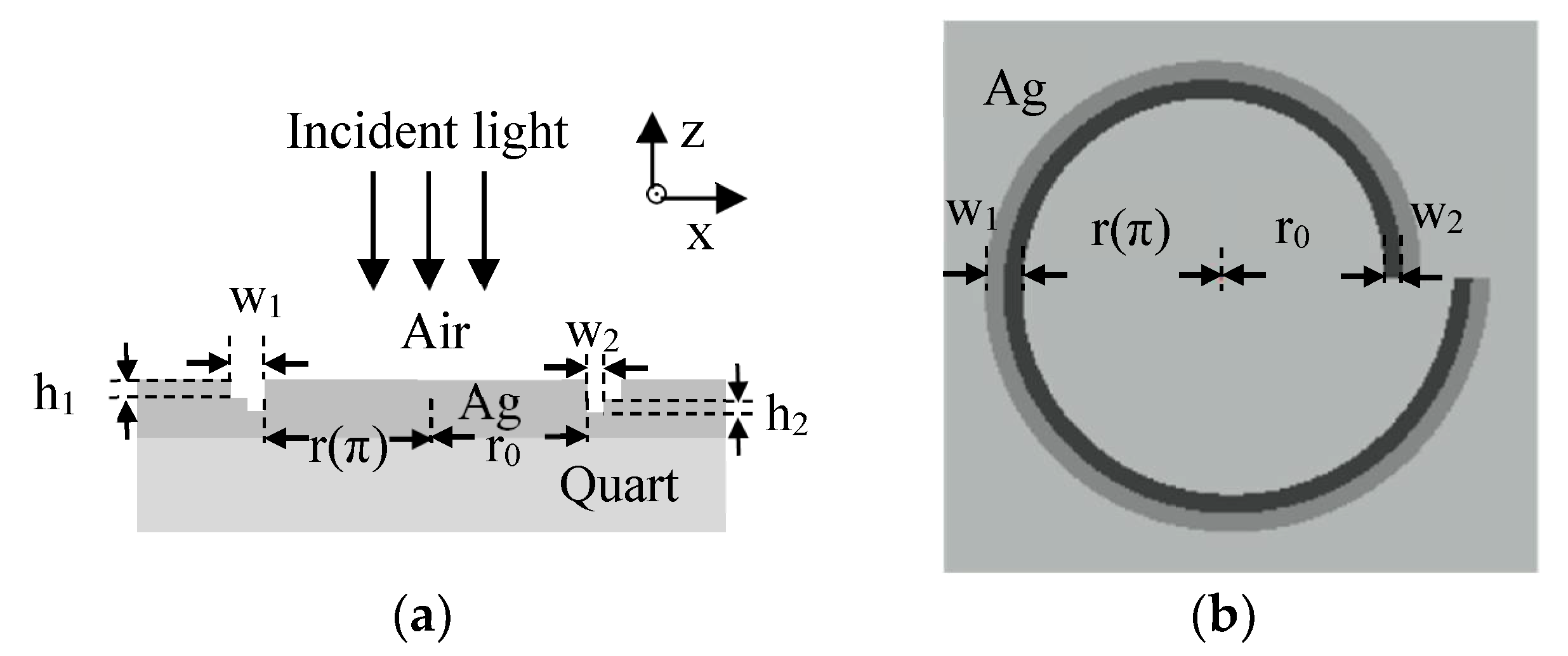
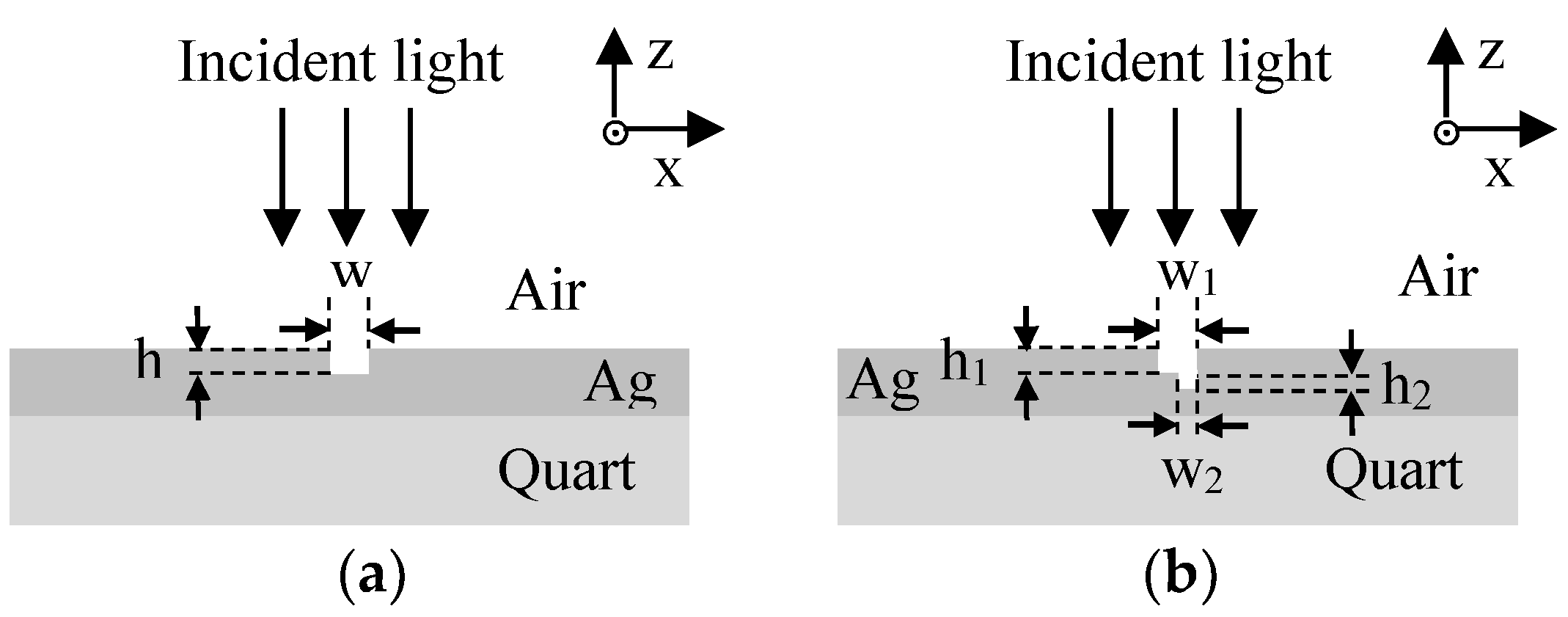
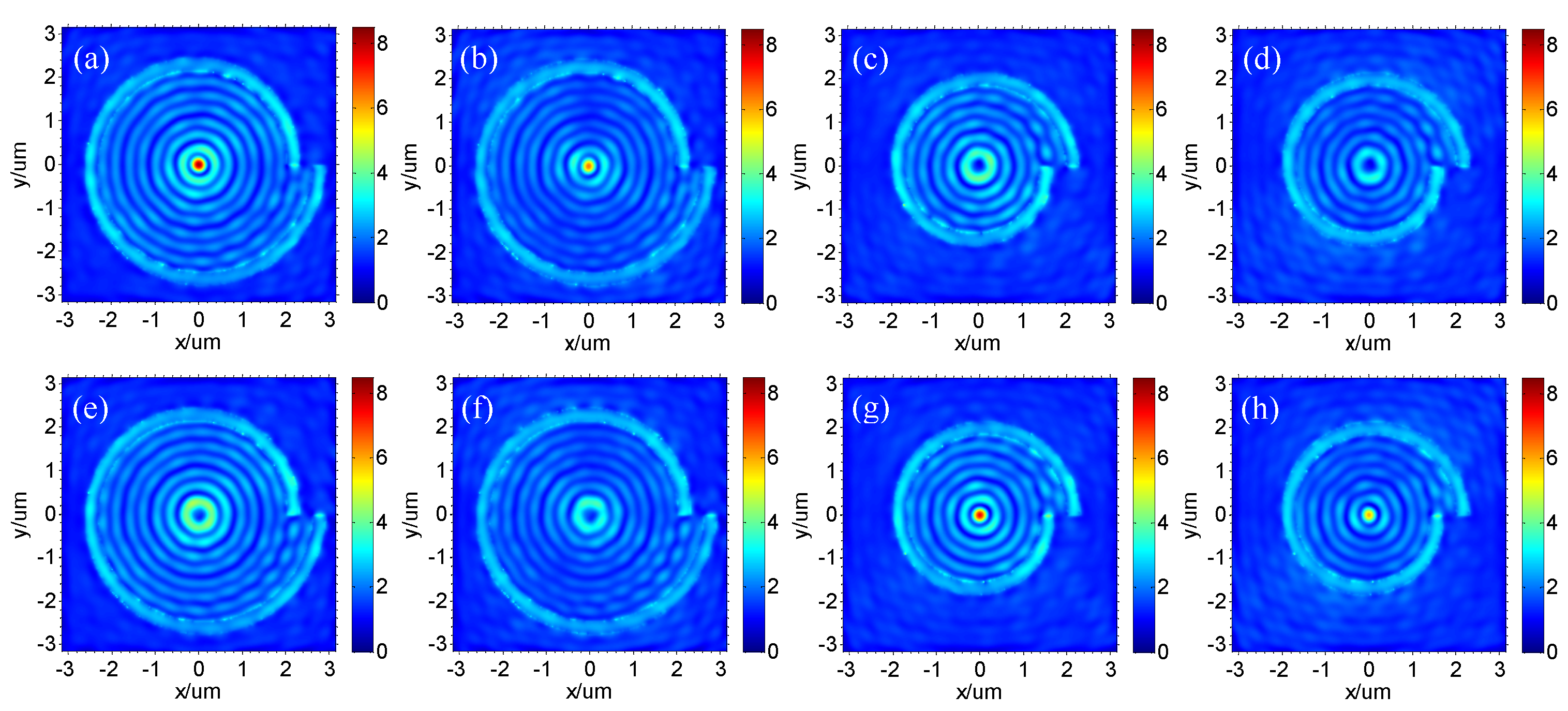
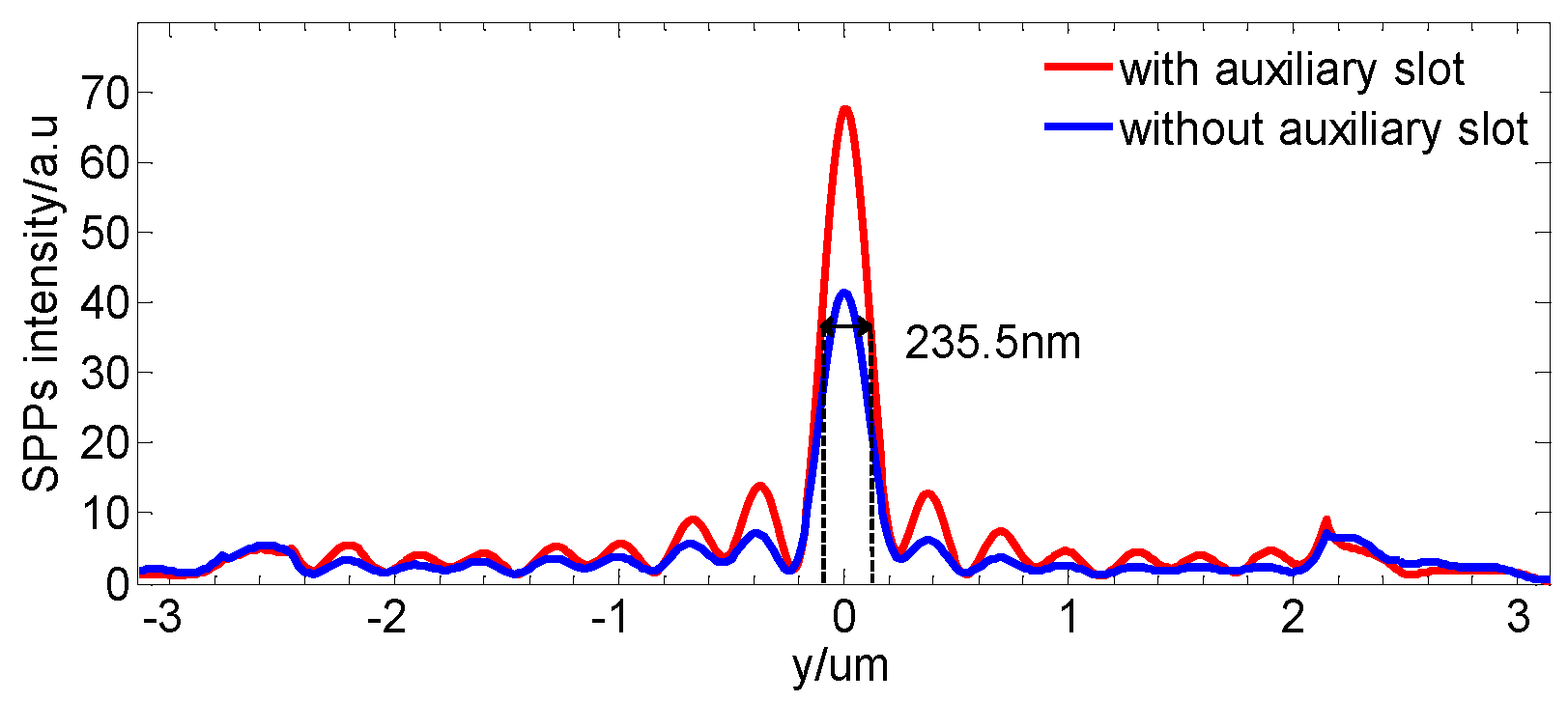
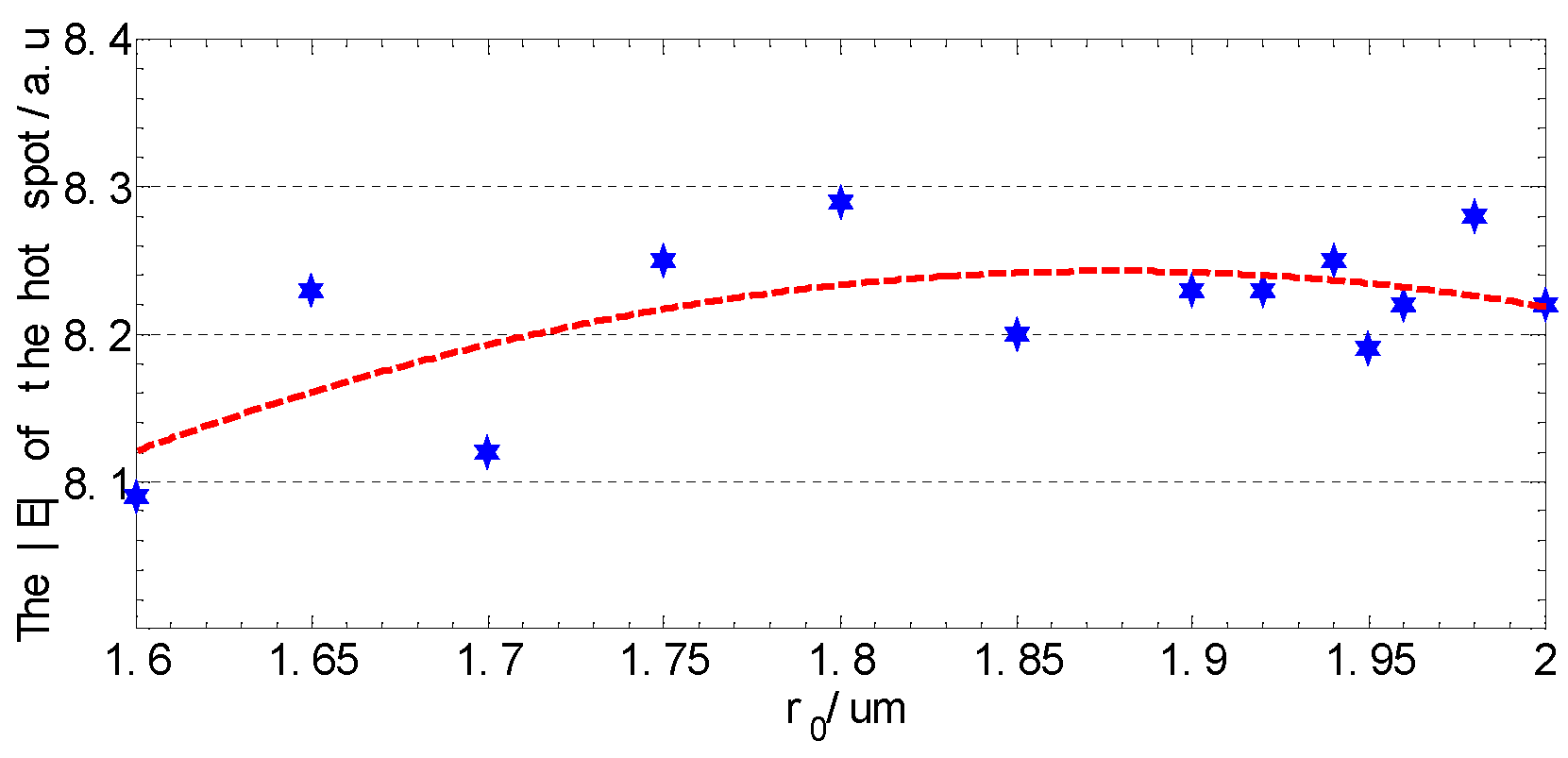
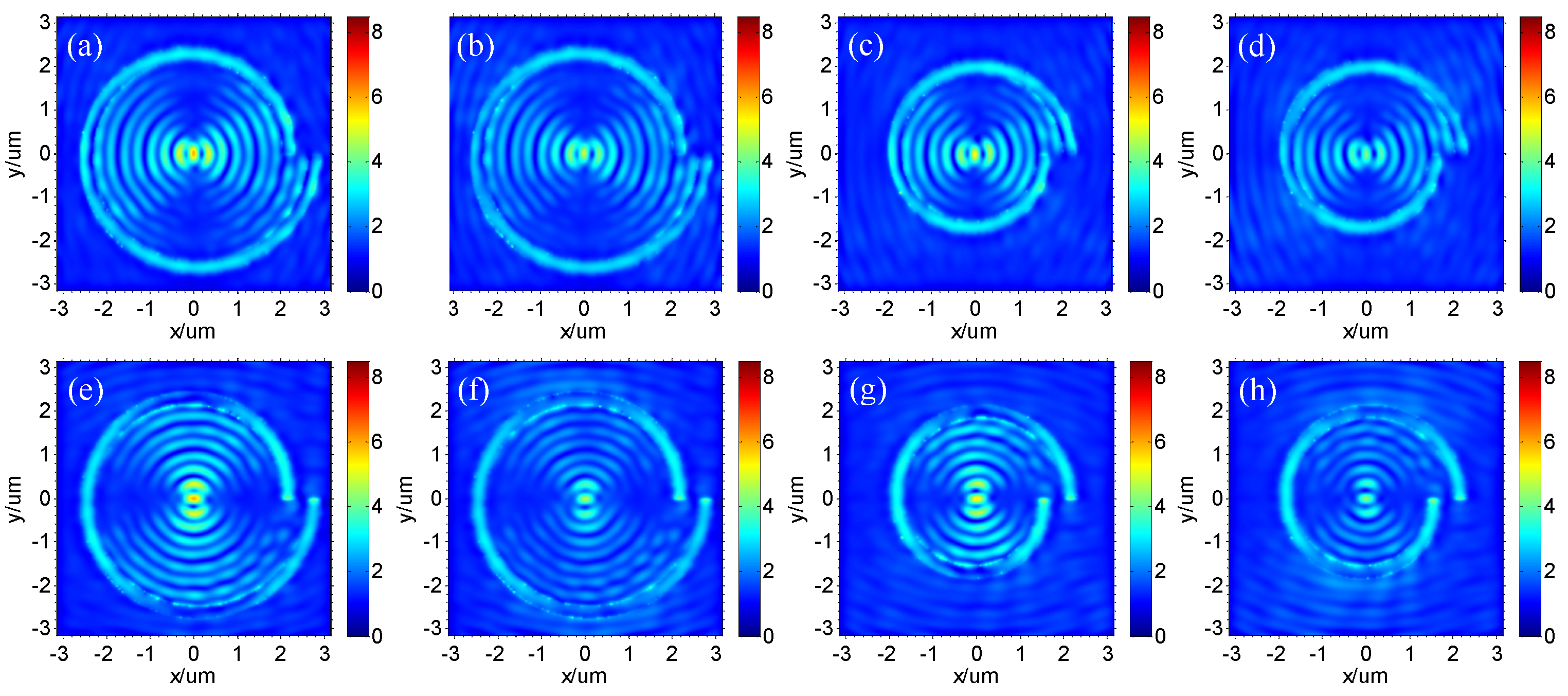
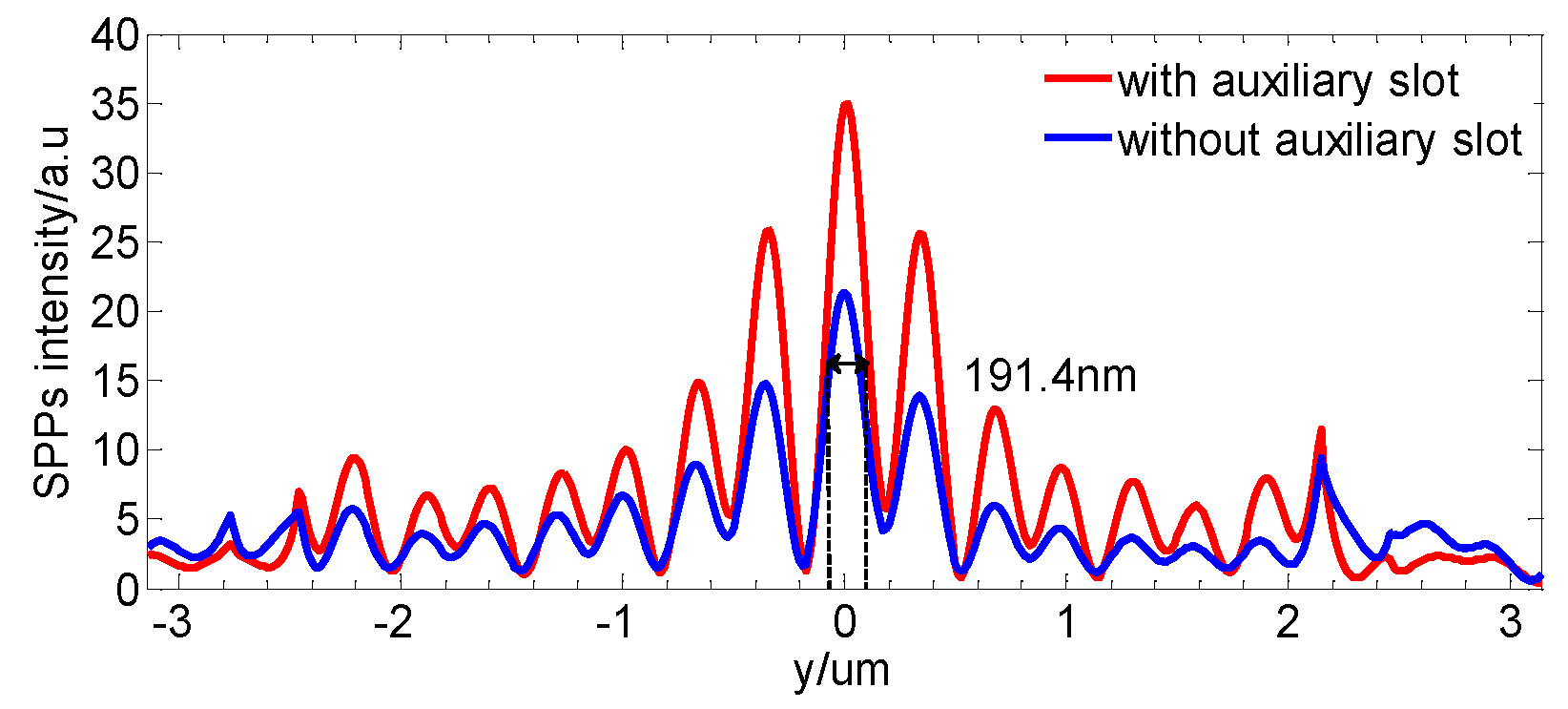
Publisher’s Note: MDPI stays neutral with regard to jurisdictional claims in published maps and institutional affiliations. |
© 2022 by the authors. Licensee MDPI, Basel, Switzerland. This article is an open access article distributed under the terms and conditions of the Creative Commons Attribution (CC BY) license (https://creativecommons.org/licenses/by/4.0/).
Share and Cite
Zhong, Y.; Wang, Q.; Wen, J.; Zhang, D.; Zhuang, S. High-Efficiency Plasmonic Lens Based on Archimedes-Spiral with Cross Section of an Asymmetric Slot. Crystals 2022, 12, 316. https://doi.org/10.3390/cryst12030316
Zhong Y, Wang Q, Wen J, Zhang D, Zhuang S. High-Efficiency Plasmonic Lens Based on Archimedes-Spiral with Cross Section of an Asymmetric Slot. Crystals. 2022; 12(3):316. https://doi.org/10.3390/cryst12030316
Chicago/Turabian StyleZhong, Yangwan, Qi Wang, Jing Wen, Dawei Zhang, and Songlin Zhuang. 2022. "High-Efficiency Plasmonic Lens Based on Archimedes-Spiral with Cross Section of an Asymmetric Slot" Crystals 12, no. 3: 316. https://doi.org/10.3390/cryst12030316
APA StyleZhong, Y., Wang, Q., Wen, J., Zhang, D., & Zhuang, S. (2022). High-Efficiency Plasmonic Lens Based on Archimedes-Spiral with Cross Section of an Asymmetric Slot. Crystals, 12(3), 316. https://doi.org/10.3390/cryst12030316





